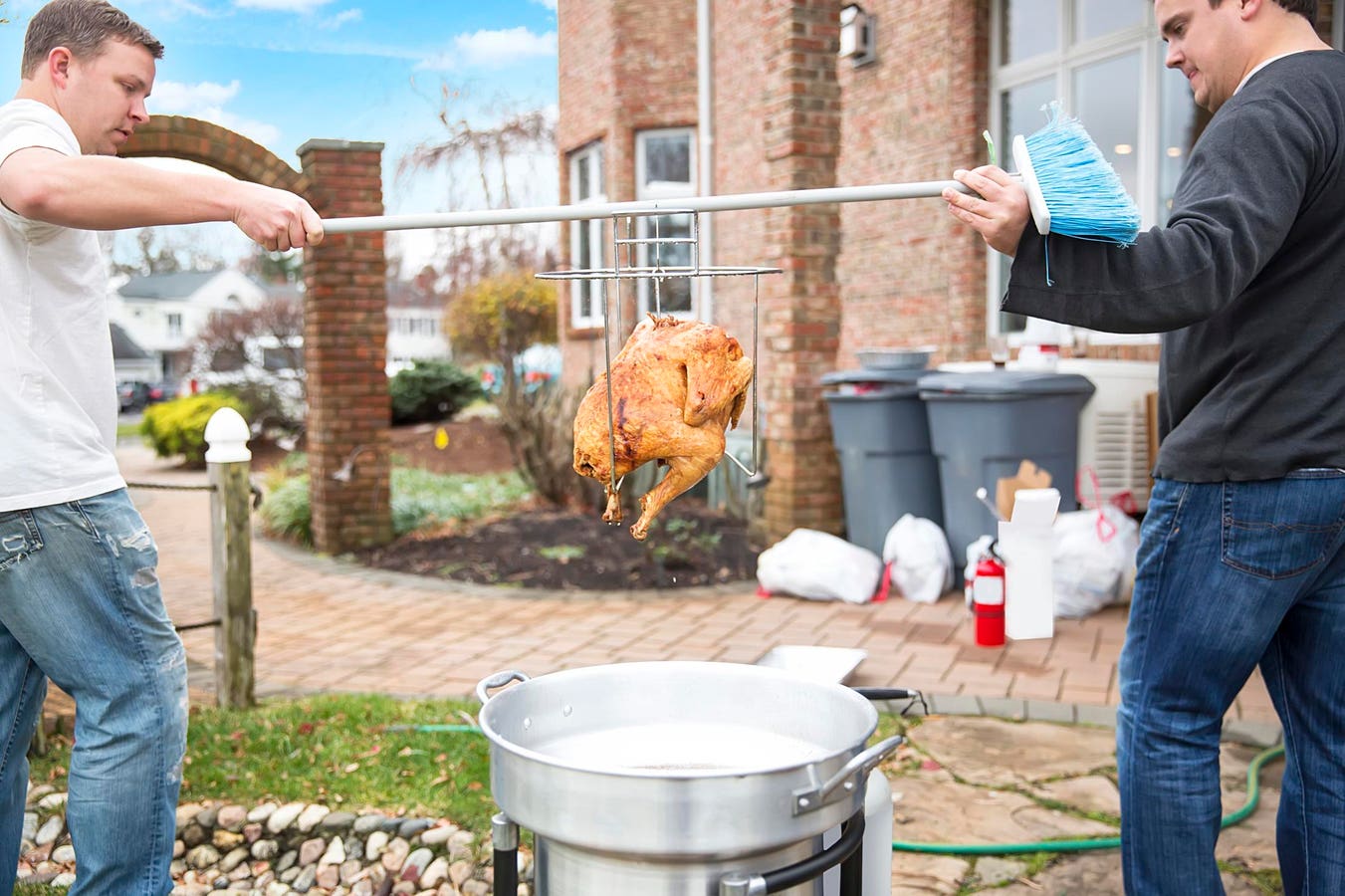Well, your house burned down. But, boy, was that deep-fried turkey tasty. Totally worth it, right?
Yeah, that’s not the type of trade-off that you should be willing to make this Thanksgiving, no matter how much you may like the super crispy meat that can result when you deep fry a turkey. Or how much you may dislike your house. This coming Thursday, it may be tempting to drop a big frozen turkey into a hot vat of boiling oil as if it were a potato so that you don’t have to wait all that time for the turkey to defrost. But heed the recent U.S. Consumer Product Safety Commission’s (USCPSC) warning on X that tried to X-out such an idea by saying, “Cook the turkey, not your home,” and posting a rather explosive accompanying video:
As you can see, deep frying a frozen turkey can leave you in deep doo-doo. This is certainly a case of oil and water not mixing well at all. A turkey can be around half water. So, a frozen turkey has within it lots of frozen water, otherwise known as ice. The boiling point for oil is around 350 degrees Fahrenheit or 175 degrees Celsius, which is substantially higher than the 212 degrees Fahrenheit or 100 degrees Celsius boiling point for water. Thus, when the ice absorbs the intense heat from boiling oil, it can quickly turn into liquid water and then into gaseous water, otherwise known as steam.
A big release of steam may be fine when it has a way of escaping. However, you never want to keep steam in a confined space. Otherwise, the steam tries to expand and builds up pressure to the point where it may explode. That’s one of the reasons why placing your bottom over a boiling tea kettle and sitting on it is a bad idea.
So think about what may happen when you lower a frozen turkey into a pot of oil. Water when it is in its liquid form is denser than oil. Therefore, the melted water from the turkey will first fall towards the bottom of the pot. But when it’s bathed in hot boiling oil, the water remains in its liquid form for only so long. Soon the liquid evaporates to become steam. In its steam form, the water molecules quickly spread apart, expanding over a thousand-fold in volume, becoming less dense than the oil. As a result, the steam tries to rapidly rise upwards. This concurrently can get a rise out of the oil too, so to speak, and rapidly push the oil out of the pot.
Now, hot oil being pushed out of a pot is already not a great situation. You don’t want to be anywhere near anything that may be like a hot oil sprinkler. But if the steam rises from deep within the pot, the resulting pressure could cause an explosion—a hot oil explosion. Moreover, should any of this splattered oil reach the flames that are heating the pot, things could get a whole lot worse. You’ve heard of the expression pouring oil on some flames? Well, this would be literally doing so and could lead to a big time fire.
That’s why you should take plenty of precautions when trying to deep fry a turkey. Before you even attempt such a deep undertaking, make sure that you are in a location that doesn’t have anything flammable nearby. Your walk-in closet, a Victoria’s Secret store or a gas station, for example, would be very bad places to deep-fry a turkey. The location should also have enough space for your to stay far enough away from the pot or whatever frying container you are using.
Don’t overfill your pot or fryer with oil either. Keep the level of oil low enough so that the oil is more likely to remain contained within the container. Remember when oil begins to boil, it’s level can rise significantly.
Again, once you’ve got the proper location and equipment and have heated up the oil to its boiling point, don’t just throw a frozen turkey in there. Thaw it completely first so that no ice remains.
Remove the wrapper too, since that might readily catch fire. Plus, even though lots of things may taste good deep-fried, you shouldn’t be eating deep-fried packaging materials.
Prior to cooking the turkey, remove the neck and giblets from the bird and pat it dry. Try to minimize the amount of water remaining on the surface of the turkey.
Oh, and when you lower the turkey into the oil, don’t just plop it down as if it were a bowling ball in a jacuzzi. Lower it very slowly and carefully. Use the proper utensils and protection when doing so. After all, you don’t want to be dipping your hands into the hot oil or using anything that may melt or catch fire.
Once the turkey is fully cooked—which takes about three to four minutes per pound of turkey—gradually lift the turkey from the pot, drain the oil, and let the turkey stand for 20 minutes. Do not underestimate how hot the turkey can still be once it leaves the oil. In the words of Guns N’ Roses, show just a little patience.
Patience is what’s needed, in general, if you want to enjoy some deep-fried turkey this Thanksgiving. Before you go deep, make sure that follow all of the aforementioned precautions. You and your home will be thankful that you did.
Read the full article here





